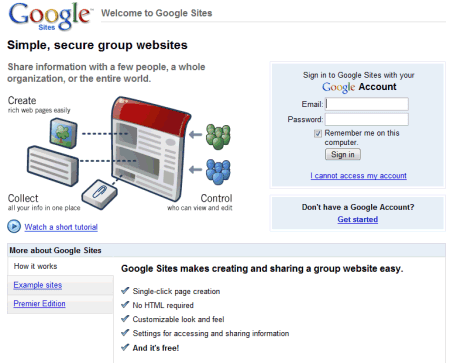
The sites are available at: http://sites.google.com/site/SITENAME and there doesn't seem to be a limit for the number of sites you can create. You can create as many web pages as you like, but each site has a storage quota of only 100 MB.
By default, each site is public, but you can make it private in the settings or when you create it. The same as in Google Docs, you're able to invite people as collaborators or viewers, but a site can have more than one owner.
Google Sites offers the same basic customization options like Blogger (themes, layout editor) and a rich text editor similar to the one from Google Docs, except that you can also embed a small number of whitelisted objects (Google Docs documents, spreadsheets, gadgets, YouTube videos).
In addition to web pages, you can also create simple blogs, lists, file cabinets and iGoogle-like dashboards. Each page can be arranged in a hierarchy and has a revision history that allows you to revert to earlier versions of a page. Google automatically creates a sitemap and can notify you when someone makes changes to the site or to an individual page.
For now, Google Sites looks pretty basic and doesn't include all the powerful features from JotSpot, the service acquired by Google and transformed into Google Sites. But that shouldn't be surprising, if you take into account that all Google services started small and gradually became more powerful and useful. I think the future of Google Sites is to combine Google's collaborative services so you can share more documents in a single page or to create blogs the same way you create calendars, to-do lists and photo galleries.
If you find Google Sites underwhelming, there are a lot of free or paid alternatives, including PBWiki, Wetpaint, Wikia and Wikispaces. There's also a nice video from Common Craft that explains "wikis in plain English":
No comments:
Post a Comment